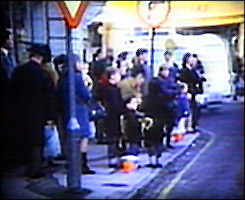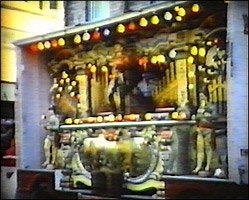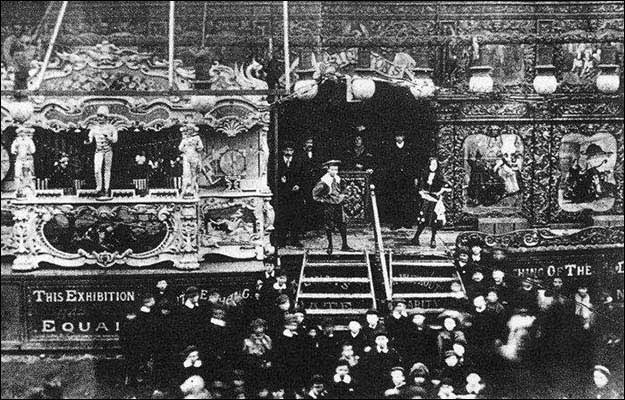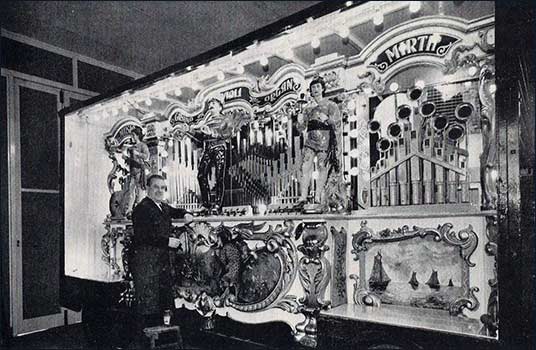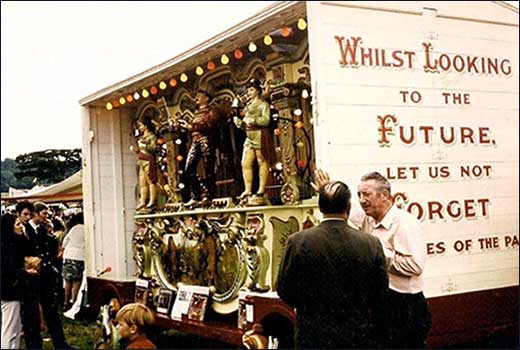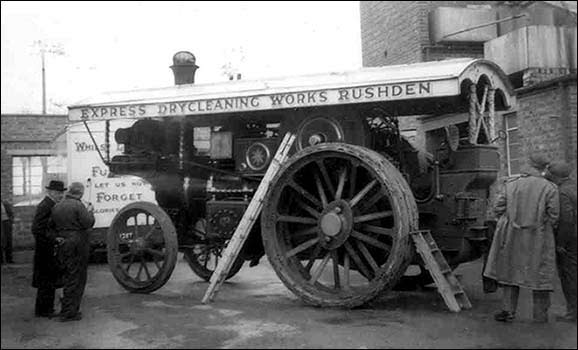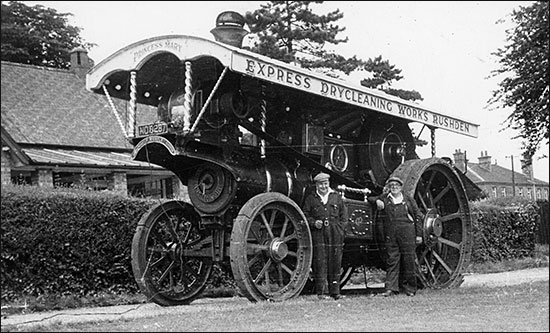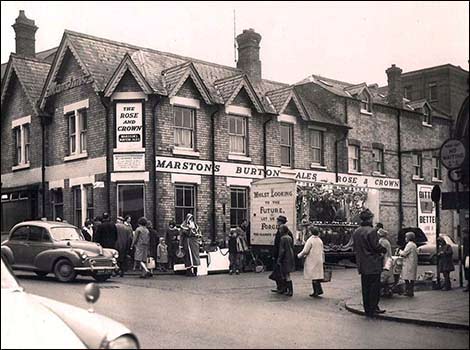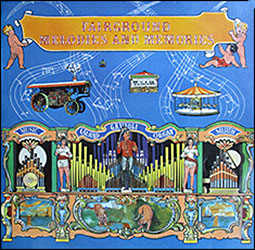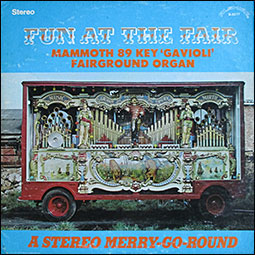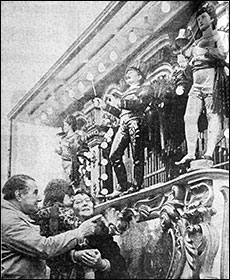You may wonder why a fairground organ and a showman's steam traction engine are owned by a Dry Cleaning Company. The explanation is simple. Mr. Arthur Mills, the Managing Director of The Express Dry Cleaning Works (Rushden) Ltd, which controls shops throughout Northamptonshire, has been a great fairground enthusiast since a boy, and his particular fascination was for fairground organs. These magnificent organs, always the centrepiece of any fairground, are now fast disappearing and the handsome steam showman's engines, also a familiar sight, have now completely vanished from this scene. Mr. Mills realising the danger of extinction decided to purchase one of each of these machines to preserve them.
Most people will remember the wonderful old rides on the fairground, the hand-carved ornamentations, the huge roundabouts and the scenic railways. Perhaps the best known of the rides were the 'Dragons' which were an art in themselves. These machines were so huge that the ride-master usually employed about 20 men to erect and pull them down. In the centre of these attractions was the fairground organ, playing tunes of the day as well as marches and popular overtures and always drawing large crowds.
This Gavioli Organ was built in 1904 for Mr. James Crighton's Bioscope Show. This type of show was the forerunner of the cinema. The organ stood at the front of the show and before each performance, the showman mounted the platform, hat in hand and announced: 'Ladies and Gentlemen, the latest marvel of our age— The Organ. It will now play.' Then a troupe of dancing girls came onto the platform and danced to the music of the organ. By then, a large crowd had gathered to view thjs spectacle during which the showman took the opportunity to point out the fabulous show that could be seen inside. 'Adults one penny, children half-penny'. These shows often played from early morning till late at night. After many faithful years with the bioscope show, this particular organ was transferred to 'roundabouts' and so travelled the fairgrounds for many years, finishing its working life with a set of modern dodgem cars just a few years ago.
But for steam power, travelling from town to town with such enormous loads would have been quite a task for any showman. As a result the handsome showman's Steam Traction Engine was developed, with its shining brass work and gay colouring. These steam giants could be seen pulling four or five huge trailers, the entire load being of some fantastic tonnage.
The showman's engine 'Princess Mary' owned by Mr. Mills, was built for London showman, Mr. Billy Nichols in 1923, by Messrs. Charles Burrell and Sons, late of Thetford, Norfolk. This engine weighs 15 tons, is 20 feet long and its back wheels are 8 feet in diameter. The 'Princess Mary' can pull a load of over 40 tons without any trouble. With the large dynamo mounted on a bracket in front of the funnel and coupled by a belt to the engine's fly-wheel she supplied all the electricity for the roundabout. At night, when the fair was in full swing, the engine would rock gently to and fro, its brass gleaming in the blaze of light from rows of coloured lamps under the full-length awning. This, together with the hiss of steam and the rhythmic throb of the pistons, was a delight to all boys from 'nine to ninety'. This fine engine was the last one to work on the fairground.
Much work has been carried out on the locomotive since it was purchased from an amusement caterer, and it is kept going by enthusiasts. The 'Princess Mary' now generates electricity for the organ motors and lights. During the summer months she can be seen puffing majestically in and around the vicinity of Rushden, Northamptonshire, going to carnivals through roads full of modern traffic.
The organ, which is housed in a large truck, is 18 feet long, 12 feet high and weighs 3 tons. When a recital is be given the entire front of the truck is removed, revealing the organ—as shown on the front of cover. The work on the organ is carried out by Mr Mills, and the technical side is taken care of by Mr Victor Chiappa, the London organ builder, whose skilful help is much appreciated. His company maintained these instruments when they were so popular on the fairground.
Many people may wonder how this instrument works. The basic principle, that of compressed air, supplied by a 3½h.p. motor, is fed to the pipes via valves. These are operated by an 89-key board. A wide cardboard roll, containing music notes in the form of perforations, works this keyboard. Each roil of musk has to be cut by hand. No mass production here!
The maintenance of this machine is a very exacting job, there being 550 notes. These lovely instruments are now being superseded by the gramophone record and the tape recorder.
This recording had to be made out-of-doors as it was obvious that no studio would be large enough to accommodate both organ and steam engine. It was not a simple job, as microphones are extremely sensitive to movement and several attempts were made before wind noises could be eliminated.
Even after 50 years' work the organ still entertains the public by giving charity recitals and taking part in local carnivals. It has also appeared on several radio programmes and was televised on the BBC programme 'Tonight'. Mr. Alan Whicker interviewed Mr. Mills at Rushden and recorded the organ.
The Fairground Organ Preservation Society, now presided over by Mr. Mills was formed to stimulate interest in these instruments and to keep enth-touch with one another. It is hoped that through this society the fairground organ will enjoy many more years of active life despite changes that progress inflicts - WHILST LOOKING INTO THE FUTURE LET US NOT FORGET THE GLORIES OF THE PAST.
